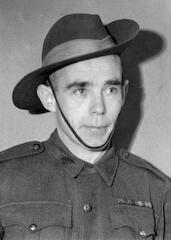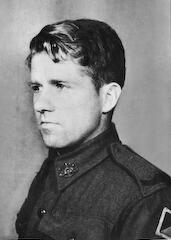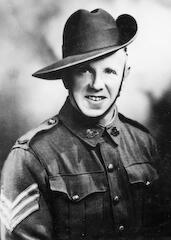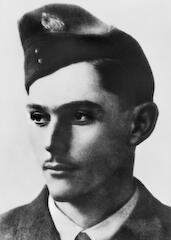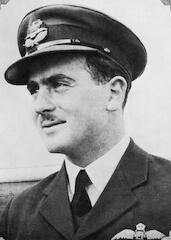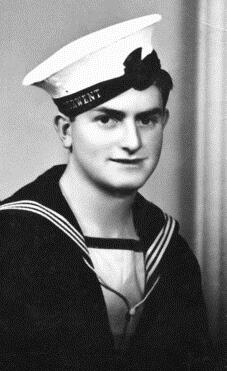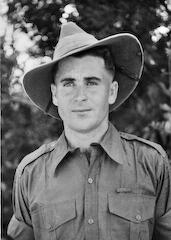
Victoria Cross recipients H–Z
Daniel Keighran VC
Corporal Daniel Alan Keighran
6th Battalion, the Royal Australian Regiment
24th August 2010, Uruzgan Province, Afghanistan
Daniel Alan KEIGHRAN was born in Nambour, Queensland on 18 June 1983 and spent his formative years in regional Queensland.
"For the most conspicuous acts of gallantry and extreme devotion to duty in action in circumstances of great peril at Derapet, Uruzgan Province, Afghanistan as part of the Mentoring Task Force One on Operation SLIPPER.
"Corporal Keighran enlisted in the Australian Army in 2000. In 2001, he was posted to the 6th Battalion, the Royal Australian Regiment (6 RAR), where he served as a Rifleman in Delta Company.
"On 24 August 2010 Corporal Keighran of the 6th Battalion Royal Australian Regiment, was a member of a partnered fighting patrol with soldiers of the Afghan National Army's 1st Kandak, 4th Brigade, 205th (Hero) Corps which was engaged by a prolonged, numerically superior and coordinated enemy attack from multiple firing points. Corporal Keighran, with complete disregard for his own safety, broke cover on multiple occasions to draw intense and accurate enemy fire to identify enemy locations and direct return fire from Australian and Afghan fire support elements. During one of these occasions, when his patrol sustained a casualty, he again, on his own initiative and in an act of exceptional courage moved from his position of cover to deliberately draw fire away from the team who were treating the casualty.
"Corporal Keighran remained exposed and under heavy fire in order to direct suppressing fire and then assist in the clearance of the landing zone to enable evacuation of the casualty. These deliberate acts of exceptional courage to repeatedly expose himself to accurate and intense enemy fire, thereby placing himself in grave danger, ultimately enabled the identification and suppression of enemy firing positions.
"In circumstances of great peril Corporal Keighran's actions were instrumental in permitting the withdrawal of the combined Australian and Afghan patrol with no further casualties.
"Corporal Keighran's acts of the most conspicuous gallantry to repeatedly expose himself to accurate and intense enemy fire, thereby placing himself in grave danger, ultimately enabled the identification and suppression of enemy firing positions by both Australian and Afghan fire support elements.
"These deliberate acts of exceptional courage in circumstances of great peril were instrumental in permitting the withdrawal of the combined Australian and Afghan patrol with no further casualties.
"His valour is in keeping with the finest traditions of the Australian Army and the Australian Defence Force."
Commonwealth of Australia Gazette S No. 167 of 2012 dated 02 Nov 2012.
[Photo courtesy of the Department of Defence]
Richard Kelliher VC
QX20656 Private Richard KELLIHER
2/25 Australian Infantry Battalion, AIF
13th September 1943, near Nadzab, New Guinea
Richard KELLIHER was born on 1 September 1910 at Ballybeggan, Tralee, County Kerry, Ireland. He died in 1963 and was buried in Springvale Cemetery, Victoria.
"During an attack by this soldier's platoon on an enemy position at Nadzab, New Guinea, on the morning of 13th September 1943 the platoon came under heavy fire of a concealed enemy machine gun post approximately 50 yards away. Five of the platoon were killed and three wounded and it was found impossible to advance without further losses. In the face of these casualties Private Kelliher suddenly, on his own initiative, and without orders dashed towards the post and hurled two grenades at it killing some of the enemy, but not all. Noting this, he then returned to his section, seized a Bren gun, again dashed forward within 30 yards of the post, and with accurate fire completely silenced it.
"Returning from his already gallant action Private Kelliher next requested permission to go forward again and rescue his wounded section leader. This he successfully accomplished, though under heavy fire from another position. Private Kelliher, by these actions, acted as an inspiration to every one in his platoon and not only enabled the advance to continue, but also saved his section leader's life. His most conspicuous bravery and extreme devotion to duty in the face of heavy enemy fire resulted in the capture of this strong enemy position."
London Gazette: 30th December 1943.
[Photo courtesy of the Australian War Memorial]
Edward Kenna VC
Private Edward KENNA
2/4th Australian Infantry Battalion, A.I.F.
15th May 1945, near Wewak, New Guinea
Private Kenna was born at Hamilton, Victoria, on 6th July 1919.
"In the South West Pacific at Wewak on 15 May 1945 during the attack near the Wirui Mission features, Private Kenna's Company had the task of capturing certain enemy positions. The only position from which observation for supporting fire could be obtained was continuously swept by enemy heavy machine-gun fire and it was not possible to bring Artillery or Mortars into action.
"Private Kenna's Platoon was ordered forward to deal with the enemy machine-gun post, so that the Company operation could proceed. When the attacking sections came into view of the enemy they were immediately engaged at very close range by heavy automatic fire from a position not previously disclosed.
"Casualties were suffered and the attackers could not move further forward. Private Kenna endeavoured to put his Bren gun into a position where he could engage the bunker but was unable to do so because of the nature of the ground. On his own initiative and without orders private Kenna stood up in full view of the enemy less than 50 yards away and engaged the bunker, firing his Bren gun from the hip.
"He remained completely exposed and continued to fire at the enemy until his magazine was exhausted. Still making a target for himself, Private Kenna discarded his Bren gun and called for a rifle. Despite the intense machine gun fire, he seized the rifle and with amazing coolness killed the gunner with his first round.
"A second automatic opened fire on Private Kenna from a different position and another of the enemy immediately tried to move into position behind the first machine gun, but Private Kenna remained standing and killed him with his next round.
"The result of Kenna's magnificent bravery in the face of concentrated fire was that the bunker was captured without further loss. The company attack proceeded to a successful conclusion, ...There is no doubt that the success of the company attack would have been seriously endangered and many casualties sustained, but for Private Kenna's magnificent courage and complete disregard for his own safety.
"His action was an outstanding example of the highest degree of bravery."
London Gazette; 6th September 1945.
William Kibby VC
William Henry Kibby VC
SX 7089 Sergeant William Henry KIBBY
2/48th Australian Infantry Battalion, AIF
23rd to 31st October 1942, in Battle of El Alamein, Western Desert
William Henry KIBBY was born at Winlaton, Durham on 15th April, 1903. He is buried in the War Cemetery at El Alamein.
"During the initial attack at Miteiriya Ridge on 23rd October, 1942, the Commander of No. 17 Platoon, to which Sergeant Kibby belonged, was killed. No sooner had Sergeant Kibby assumed command than his platoon was ordered to attack strong enemy positions holding up the advance of his company.
"Sergeant Kibby immediately realised the necessity for quick decisive action, and without thought for his personal safety he dashed forward towards the enemy post firing his Tommygun. This rapid and courageous individual action resulted in the complete silencing of the enemy fire, by the killing of three of the enemy, and the capture of twelve others. With these posts silenced, his Company was then able to continue the advance.
"On the night of 30th-31st October, when the battalion attacked "ring contour" 25, behind the enemy lines, it was necessary for No. 17 Platoon to move through the most withering enemy machine-gun fire in order to reach its objective. These conditions did not deter Sergeant Kibby from pressing forward right to the objective, despite his platoon being mown down by machine-gun fire from point blank range.
"One pocket of resistance still remained and Sergeant Kibby went forward alone, throwing grenades to destroy the enemy now only a few yards distant. Just as success appeared certain he was killed by a burst of machine-gun fire. Such outstanding courage, tenacity of purpose and devotion to duty was entirely responsible for the successful capture of the Company's objective.
"His work was an inspiration to all and he left behind him an example and memory of a soldier who fearlessly and unselfishly fought to the end to carry out his duty."
Abridged version - London Gazette: 28th January 1943.
Bruce Kingsbury VC
Bruce Steel Kingsbury VC
VX19139 Private Bruce Steel KINGSBURY
2/14th Australian Infantry Battalion AIF
29th August 1942, at Isurava, Papua
"Bruce Steel Kingsbury was born in Armadale, Melbourne on 8th January, 1918. He is buried in the Port Moresby (Bomana) War Cemetery, Papua.
"In New Guinea, the Battalion to which Private Kingsbury belonged had been holding a position in the Isurava area for two days against continuous and fierce enemy attacks.
"On 29th August 1942, the enemy attacked in such force that they succeeded in breaking through the Battalion's right flank, creating serious threats both to the rest of the Battalion and to its Headquarters. To avoid the situation becoming more desperate it was essential to regain immediately lost ground on the right flank.
"Private Kingsbury, who was one of the few survivors of a Platoon which had been overrun and severely cut about by the enemy, immediately volunteered to join a different platoon which had been ordered to counter-attack. He rushed forward firing the Bren gun from his hip through terrific machine-gun fire and succeeded in clearing a path through the enemy.
"Continuing to sweep enemy positions with his fire and inflicting an extremely high number of casualties on them, Private Kingsbury was then seen to fall to the ground shot dead by the bullet from a sniper hiding in the wood.
"Private Kingsbury displayed a complete disregard for his own safety. His initiative and superb courage made possible the recapture of a position which undoubtedly saved Battalion Headquarters, as well as causing heavy casualties amongst the enemy.
"His coolness, determination and devotion to duty in the face of great odds was an inspiration to his comrades."
London Gazette: 5th February 1943.
John Mackey VC
NX 20317 Corporal John Bernard Mackey
2/3rd Australian Pioneer Battalion, A.I.F.
12th May 1945, at Tarakan Island
John Bernard MACKEY was born on 16 May 1922 at Leichhardt, Sydney. He was buried in Labuan War Cemetery.
"Corporal Mackey was in charge of a section of the 2/3rd Australian Pioneer Battalion in the attack on the feature known as Helen, East of Tarakan town. Led by Corporal Mackey the section moved along a narrow spur with scarcely width for more than one man when it came under fire from three well-sited positions near the top of a very steep, razor-backed ridge.
"The ground fell away almost sheer on each side of the track making it almost impossible to move to a flank so Corporal Mackey led his men forward. He charged the first Light Machine-Gun position but slipped and after wrestling with one enemy, bayoneted him, and charged straight on to the Heavy Machine-Gun which was firing from a bunker position six yards to his right. He rushed this post and killed the crew with grenades.
"He then jumped back and changing his rifle for a sub-machine-gun he attacked further up the steep slope another Light Machine-Gun position which was firing on his platoon. Whilst charging, he fired his gun and reached within a few feet of the enemy position when he was killed by Light Machine-Gun fire but not before he had killed two more enemy.
"By his exceptional bravery and complete disregard for his own life, Corporal Mackey 21 was largely responsible for the killing of seven Japanese soldiers and the elimination of two machine-gun posts, which enabled his platoon to gain its objective, from which the Company continued to engage the enemy.
"His fearless action and outstanding courage were an inspiration to the whole battalion."
London Gazette: 8th November 1945.
Rawdon Middleton VC
402745 Pilot Officer Rawdon Hume MIDDLETON R.A.A.F.
Attached to 149 Squadron, R.A.F.
Night of 28th-29th November, 1942, in raid on Turin, Italy
Rawdon Hume Middleton was born at Waverley, New South Wales on 22nd July, 1916. His commission as Pilot Officer was backdated posthumously to 15 November, 1942. His body was washed ashore at Dover on 1st February, 1943, and he is buried in the Churchyard of St John's, Beck Row, Suffolk, England.
"Flight Sergeant Middleton was captain and first pilot of a Stirling aircraft detailed to attack the Fiat works at Turin in November 1942. Great difficulty was experienced on the way to the target and while over the target the aircraft was hit by anti-aircraft fire.
"Flight Sergeant Middleton was badly wounded and his right eye was destroyed. The second pilot was also badly wounded. The possibilities of abandoning the aircraft or landing in northern France were discussed but Flight Sergeant Middleton stated his intention to attempt to reach the English coast.
"After crossing the Channel there was only sufficient fuel for five minutes flying. Flight Sergeant Middleton flew the aircraft parallel with the coast and ordered the crew to abandon the aircraft. Five of the crew left the aircraft and two remained to assist him. The aircraft crashed into the sea and all remaining onboard were killed.
"Flight Sergeant Middleton was determined to attack the target regardless of the consequences and not to allow his crew to fall into enemy hands. While all the crew displayed heroism of a high order, the urge to do so came from Flight Sergeant Middleton, whose fortitude and strength of will made possible the completion of the mission.
"His devotion to duty in the face of overwhelming odds is unsurpassed in the annals of the Royal Air Force".
London Gazette: 15 January, 1943.
William Newton VC
250748 Flight Lieutenant William Ellis Newton
No. 22 Squadron, R.A.A.F
16th March, 1943, on Salamaua Isthmus, New Guinea
William Ellis Newton was born at St. Kilda, Victoria on 8th June, 1919. His body was recovered when Salamaua was recaptured by Australian troops and he was buried in the Lae War Cemetery, New Guinea.
"Flight Lieutenant Newton served in New Guinea from May 1942 to March 1943 and completed 52 operational sorties. When leading an attack on 16 March, 1943 his Boston aircraft was hit repeatedly and although it was crippled he managed to return the aircraft to base and make a successful landing. He returned next day to the same location. His aircraft was again hit and it burst into flames.
"Flight Lieutenant Newton maintained control and calmly turned his aircraft away and flew along the shore. He saw it as his duty to keep the aircraft in the air and to take his crew as far away as possible from the enemy's positions. With great skill he brought his blazing aircraft down on the water.
"Two members of the crew extricated themselves and were seen swimming to shore. One of them was Flight Lieutenant Newton. He was captured and later executed on 29 March, 1943, at Salamaua, New Guinea.
"Without regard to his own safety, he had done all that man could do to prevent his crew falling into enemy hands.
"Flight Lieutenant Newton's many examples of conspicuous bravery have rarely been equalled and will serve as a shining inspiration to all who follow him."
London Gazette: 19 October, 1943.
Frank Partridge VC
Private Frank John Partridge
8th Australian Infantry Battalion AIF
24th July 1945, Bonis Peninsula, at Bougainville
Frank Partridge was born on 29 November 1924 at Grafton, New South Wales. He was killed in a motor accident on 23rd March 1964 and was buried at Macksville, New South Wales.
"On 24th July 1945 two fighting patrols, 8th Australian Infantry Battalion, were given the task of eliminating an enemy outpost in Bougainville which denied any forward movement by our troops. Private Partridge was a rifleman in a section which came under heavy medium machine- gun fire. He was hit twice in the left arm and again in the left thigh, while the Bren gunner was killed and two others seriously injured."
"Private Partridge quickly appreciated the extreme gravity of the situation and decided that the only possible solution was personal action by himself. Despite wounds and with complete disregard for his own safety, Private Partridge rushed forward under a terrific burst of enemy fire and retrieved the Bren gun from alongside the dead gunner."
"He handed the Bren gun to another man to provide covering fire while he rushed the bunker, into which he threw a grenade and silenced the medium machine gun. Under cover of the grenade burst, he dived into the bunker and in a fierce hand to hand fight, he killed the only living occupant with his knife. Private Partridge then attacked another bunker, but weakness from loss of blood, compelled him to halt, when he was unable to continue."
"With the way clear by the silencing of the enemy machine-gun, the Platoon moved forward and established a defensive perimeter. However heavy enemy medium machine-gun and rifle fire soon created an untenable situation for the Platoon, which withdrew."
"Despite his wounds Private Partridge remained in action until the Platoon had withdrawn after recovering their casualties. The information gained during these actions enabled another, this time successful attack to be mounted."
"The serious situation during the fight of the two patrols was retrieved only by the outstanding gallantry and devotion to duty displayed by Private Partridge, which inspired his comrades to heroic action. "The subsequent successful capture of the position was due entirely to the incentive derived by his comrades from the outstanding heroism and fortitude displayed by Private Partridge."
London Gazette: 22nd January 1946.
Keith Payne VC
12222 Warrant Officer Class II Keith Payne
Australian Army Training Team, Vietnam
24th May 1969, Kontum Province, South Vietnam
Keith Payne was born on 30 August 1930 at Ingham, Queensland.
"On 24th May 1969, in Kontum Province, Warrant Officer Payne was Commanding 212th Company of 1st Mobile Strike Force Battalion when the battalion was attacked by a North Vietnamese force of superior strength. Under this heavy attack the indigenous soldiers began to fall back.
"Directly exposing himself to the enemy's fire, Warrant Officer Payne, through his own efforts, temporarily held off the assaults by alternately firing his weapon and running from position to position collecting grenades and throwing them at the assaulting enemy. While doing this he was wounded in the hand and arms.
"Despite his outstanding efforts, the indigenous soldiers gave way under the enemy's increased pressure and the Battalion Commander, together with several advisors and a few soldiers, withdrew. Paying no attention to his wounds and under extremely heavy enemy fire, Warrant Officer Payne covered his withdrawal by throwing grenades and firing his own weapon at the enemy who were attempting to follow up.
"Still under fire, he then ran across exposed ground to head off his own troops who were withdrawing in disorder. He successfully stopped them and organised the remnants of his and the second company into a temporary defensive perimeter by nightfall.
"Having achieved this, Warrant Officer Payne of his own accord and at great personal risk, moved out of the perimeter into the darkness alone in an attempt to find the wounded and other indigenous soldiers. He finally collected forty lost soldiers, some of whom had been wounded and returned with this group to the temporary defensive position he had left, only to find that the remainder of the battalion had moved back.
"Undeterred by this setback and personally assisting a seriously wounded American advisor he led the group through the enemy to the safety of his battalion base. His sustained and heroic personal efforts, in this action were outstanding and undoubtedly saved the lives of a large number of his indigenous soldiers and several of his fellow advisors.
"Warrant Officer Payne's repeated acts of exceptional personal bravery and unselfish conduct in this operation were an inspiration to all Vietnamese, United States and Australian soldiers who served with him. His conspicuous gallantry was in the highest traditions of the Australian Army."
London Gazette; 19 September 1969.
Reginald Rattey VC
NX 102964 Corporal Reginald Roy Rattey
25th Australian Infantry Battalion AIF
22nd March 1945, at Bougainville
Corporal Rattey was born at Barmedman, New South Wales on 28th March 1918. He died on 10 January 1986 and was buried in the West Wyalong Lawn Cemetery, New South Wales.
"In the South West Pacific, on 22nd March 1945 a company of an Australian Infantry Battalion was ordered to capture a strongly held enemy position astride Buin Road, South Bougainville. The attack was met by extremely heavy fire and all forward movement was stopped with casualties mounting.
"Corporal Rattey quickly appreciated the serious situation delaying the advance could only be averted by silencing enemy fire from automatic weapons in bunkers, which dominated all the lines of approach. He determined that a bold push by himself alone would surprise the enemy and offered the best chance of success.
"With amazing courage he rushed forward firing his Bren gun and hurling grenades. This completely neutralised enemy fire. Corporal Rattey, now without grenades, raced back to his section under extremely heavy fire and obtained two grenades with which he again rushed the remaining bunkers, effectively silencing all opposition and enabling his company to continue its advance.
"A little later the advance of his company was again held up by a heavy machine gun firing across the front. Without hesitation Corporal Rattey rushed the gun and silenced it. The company again continued its advance and gained its objective, which was consolidated.
"The serious situation was turned into a brilliant success, entirely by the courage, cool planning and stern determination of Corporal Rattey. His bravery was an incentive to the entire company, who fought with inspiration derived from the gallantry of Corporal Rattey, despite the stubborn opposition to which they were subjected."
London Gazette: 26th July 1945.
Benjamin Roberts-Smith VC
NX 8216385 Corporal Benjamin Roberts-Smith
Special Air Service Regiment
11th June 2010, Kandahar Province, Afghanistan
Ben Roberts-Smith was born in Perth on 1 November 1978.
"For the most conspicuous gallantry in action in circumstances of extreme peril as Patrol Second-in-Command, Special Operations Task Group on Operation SLIPPER.
"Corporal Benjamin Roberts-Smith enlisted in the Australian Regular Army in 1996. After completing the requisite courses, he was posted the 3rd Battalion, the Royal Australian Regiment where he saw active service in East Timor. In January 2003, he successfully completed the Australian Special Air Service Regiment Selection Course.
"During his tenure with the Regiment, he deployed on Operation VALIANT, SLATE, SLIPPER, CATALYST and SLIPPER II.
"Corporal Benjamin Roberts-Smith was awarded the Medal for Gallantry for his actions in Afghanistan in 2006. On the 11th June 2010, a troop of the Special Operations Task Group conducted a helicopter assault into Tizak, Kandahar Province, in order to capture or kill a senior Taliban commander.
"Immediately upon the helicopter insertion, the troop was engaged by machine gun and rocket propelled grenade fire from multiple, dominating positions. Two soldiers were wounded in action and the troop was pinned down by fire from three machine guns in an elevated fortified position to the south of the village.
"Under the cover of close air support, suppressive small arms and machine gun fire, Corporal Roberts-Smith and his patrol manoeuvred to within 70 metres of the enemy position in order to neutralise the enemy machine gun positions and regain the initiative. Upon commencement of the assault, the patrol drew very heavy, intense, effective and sustained fire from the enemy position.
"Corporal Roberts-Smith and his patrol members fought towards the enemy position until, at a range of 40 metres, the weight of fire prevented further movement forward. At this point, he identified the opportunity to exploit some cover provided by a small structure.
"As he approached the structure, Corporal Roberts-Smith identified an insurgent grenadier in the throes of engaging his patrol. Corporal Roberts-Smith instinctively engaged the insurgent at point-blank range resulting in the death of the insurgent.
"With the members of his patrol still pinned down by the three enemy machine gun positions, he exposed his own position in order to draw fire away from his patrol, which enabled them to bring fire to bear against the enemy. His actions enabled his Patrol Commander to throw a grenade and silence one of the machine guns.
"Seizing the advantage and demonstrating extreme devotion to duty and the most conspicuous gallantry, Corporal Roberts-Smith, with a total disregard for his own safety, stormed the enemy position killing the two remaining machine gunners.
"His act of valour enabled his patrol to break-in to the enemy position and to lift the weight of fire from the remainder of the troop who had been pinned down by the machine gun fire. On seizing the fortified gun position, Corporal Roberts-Smith then took the initiative again and continued to assault enemy positions in depth during which he and another patrol member engaged and killed further enemy.
"His acts of selfless valour directly enabled his troop to go on and clear the village of Tizak of Taliban. This decisive engagement subsequently caused the remainder of the Taliban in Shah Wali Kot District to retreat from the area.
"Corporal Roberts-Smith's most conspicuous gallantry in a circumstance of extreme peril was instrumental to the seizure of the initiative and the success of the troop against a numerically superior enemy force.
"His valour was an inspiration to the soldiers with whom he fought alongside and is in keeping with the finest traditions of the Australian Army and the Australian Defence Force."
Commonwealth of Australia Gazette Special Gazette No. S 12, 24 January 2011.
Rayene Simpson VC
Rayene Simpson VC
Warrant Officer Class II Rayene Stewart SIMPSON DCM
Australian Army Training Team
6th and 11th May 1969, in Kontum Province, South Vietnam
Rayene Simpson was born on 16th February 1926 at Chippendale, New South Wales. He died at Tokyo, Japan on 18th October 1978 and was buried at the Yokohama War Cemetary, Japan.
"On 6th May 1969, Warrant Officer Simpson was serving as Commander of 232nd Mobile Strike Force of 5th Special Forces Group on a search and clear operation in Kontum Province, near the Laotian border. When one of his platoons became heavily engaged with the enemy, he led the remainder of his company to its assistance.
"As the company moved forward, an Australian Warrant Officer commanding one of the platoons was seriously wounded and the assault began to falter. Warrant Officer Simpson, at great personal risk carried the Warrant Officer to safety. He then returned to his company where, with complete disregard for his safety, he crawled forward to within ten metres of the enemy and threw grenades into their positions.
"On 11 May 1969, in the same operation, Warrant Officer Simpson's Battalion Commander was killed and an Australian Warrant Officer and several others wounded. Warrant Officer Simpson quickly organised two platoons and led them to the position of the contact. Warrant Officer Simpson came under heavy fire.
"Disregarding his own safety, he moved forward in the face of accurate enemy machine gun fire, in order to cover the initial evacuation of casualties. At the risk of almost certain death he made several attempts to move further forward towards his Battalion Commander's body but on each occasion he was stopped by heavy fire.
"Realising the position was becoming untenable, Warrant Officer Simpson alone and still under enemy fire covered the withdrawal until the wounded were removed from the immediate vicinity.
"Warrant Officer Simpson's repeated acts of personal bravery in this operation were an inspiration to all Vietnamese, United States and Australian soldiers who served with him. His conspicuous gallantry was in the highest tradition of the Australian Army."
London Gazette: 26 August 1969-1 Supplement, 29 August 1969.
Edward Sheean VC
H1617 Ordinary Seaman Edward SHEEAN
Royal Australian Naval Reserve (Seagoing)
1st December 1942, Timor Sea
"For the most conspicuous gallantry and a pre-eminent act of valour in the presence of the enemy during a Japanese aerial attack on HMAS Armidale in the Timor Sea on 1 December 1942.
"On 1 December 1942, during operations in the Timor Sea, HMAS Armidale came under aerial bombardment and torpedo attack from Japanese aircraft. Shortly after the commencement of the attack, Armidale was hit by a torpedo and began listing to port. One minute later the ship was hit by a second torpedo which broke the vessel's back, causing the Captain to order abandon ship.
"Ordinary Seaman Sheean, one of the youngest and most junior ranked members of Armidale’s Ship's Company, made his way to the stowage position of the motor-boat and assisted in its launch. As the enemy continued to fire upon the ship and his shipmates who were already in the water, Ordinary Seaman Sheean decided to forgo his opportunity for survival by not abandoning ship and returning to his Action Station to man the aft Oerlikon gun, where he was the loader, not the gunner. Despite being wounded, he strapped himself into the gun and commenced firing at the enemy, damaging at least two enemy aircraft.
"Ordinary Seaman Sheean's actions disrupted and distracted the enemy from strafing and killing his defenceless shipmates in the water. He sacrificed his life trying to save his shipmates and, despite his wounds, he continued firing the gun until the ship sank and took him to his death. His pre-eminent act of valour and most conspicuous gallantry saved Australian lives. His heroism became the standard to which the men and women of the Australian Defence Force aspire."
Commonwealth of Australia Gazette No. C2020G00960 dated 1 December 2020
Leslie Starcevich VC
WX11519 Private Leslie Thomas STARCEVICH
2/43rd Australian Infantry Battalion AIF
28th June 1945, near Beaufort, British North Borneo
Leslie Starcevich was born on 5th September 1918 at Subiaco, Western Australia. He died on 17th November 1989 and was buried at Esperance, Western Australia.
"Private L. Starcevich was a member of 2/43rd Australian Infantry Battalion during the capture of Beaufort, North Borneo. During the approach along a thickly wooded spur, the enemy was encountered at a position where movement off the single track leading into the enemy defences was difficult and hazardous.
"When the leading section came under fire from two enemy machine-gun posts and suffered casualties, Private Starcevich, who was a Bren gunner, moved forward and assaulted each post in turn. He rushed each post firing his Bren gun from the hip, killed five enemy and put the remaining occupants of the posts to flight.
"The advance progressed until the section came under fire from two machine gun posts which halted the section temporarily. Private Starcevich again advanced fearlessly, firing his Bren gun from the hip and ignoring the hostile fire, captured both posts single handed, disposing of seven enemy.
"These daring efforts enabled the Company to increase the momentum of its attack and so relieve pressure on another Company which was attacking from another direction. The outstanding gallantry of Private Starcevich in carrying out these attacks single handed with complete disregard of his own personal safety resulted in the decisive success of the action."
London Gazette: 8th November 1945.
Kevin Wheatley VC
29890 Warrant Officer Class II Kevin Arthur WHEATLEY
Australian Army Training Team
13th November 1965, Tra Bong Valley, Quang Ngai Province, Vietnam
"Warrant Officer Wheatley enlisted in the Australian Regular Army in 1956. He served in Malaya with 3rd Battalion, The Royal Australian Regiment from 1957 to 1959 and then with the 2nd and 1st Battalions of the Regiment until February 1965 when he was posted to the Australian Army Training Team Vietnam.
"His posting in this area has been distinguished by meritorious and gallant service.
On 13th November 1965 at approximately 1300 hours, a Vietnamese Civil Irregular Defence Group company commenced a search and destroy operation in the Tra Bong valley, 15 kilometres East of Tra Bong Special Forces Camp in Quang Ngai Province. Accompanying the force were Captain F. Fazekas, senior Australian Advisor, with the centre platoon, and Warrant Officers K. A. Wheatley and R. J. Swanton with the right hand" platoon. At about 1340 hours, Warrant Officer Wheatley reported contact with Viet Cong elements. The Viet Cong resistance increased in strength until finally Warrant Officer Wheatley asked for assistance. Captain Fazekas immediately organised the centre platoon to help and personally led and fought it towards the action area. While moving towards this area he received another radio message from Warrant Officer Wheatley to say that Warrant Officer Swanton had been hit in the chest, and requested an air strike and an aircraft, for the evacuation of casualties.
"At about this time the right platoon broke in the face of heavy Viet Cong fire and began to scatter. Although told by the Civil Irregular Defence Group medical assistant that Warrant Officer Swanton was dying, Warrant Officer Wheatley refused to abandon him. He discarded his radio to enable him to half drag, half carry Warrant Officer Swanton, under heavy machine gun and automatic rifle fire, out of the open rice paddies into the comparative safety of a wooded area, some 200 metres away. He was assisted by a Civil Irregular Defence Group member, Private Dinh Do who, when the Viet Cong were only some ten metres away, urged him to leave his dying comrade. Again he refused, and was seen to pull the pins from two grenades and calmly awaited the Viet Cong, holding one grenade in each hand. Shortly afterwards, two grenade explosions were heard, followed by several bursts of fire.
"The two bodies were found at first light next morning after the fighting had ceased, with Warrant Officer Wheatley lying beside Warrant Officer Swanton. Both had died of gunshot wounds.
"Warrant Officer Wheatley displayed magnificent courage in the face of an overwhelming Viet Cong force which was later estimated at more than a company. He had the clear choice of abandoning a wounded comrade and saving himself by escaping through the dense timber or of staying with Warrant Officer Swanton and thereby facing certain death. He deliberately chose the latter course. His acts of heroism, determination and unflinching loyalty in the face of the enemy will always stand as examples of the true meaning of valour."
London Gazette: 13th December, 1966.

